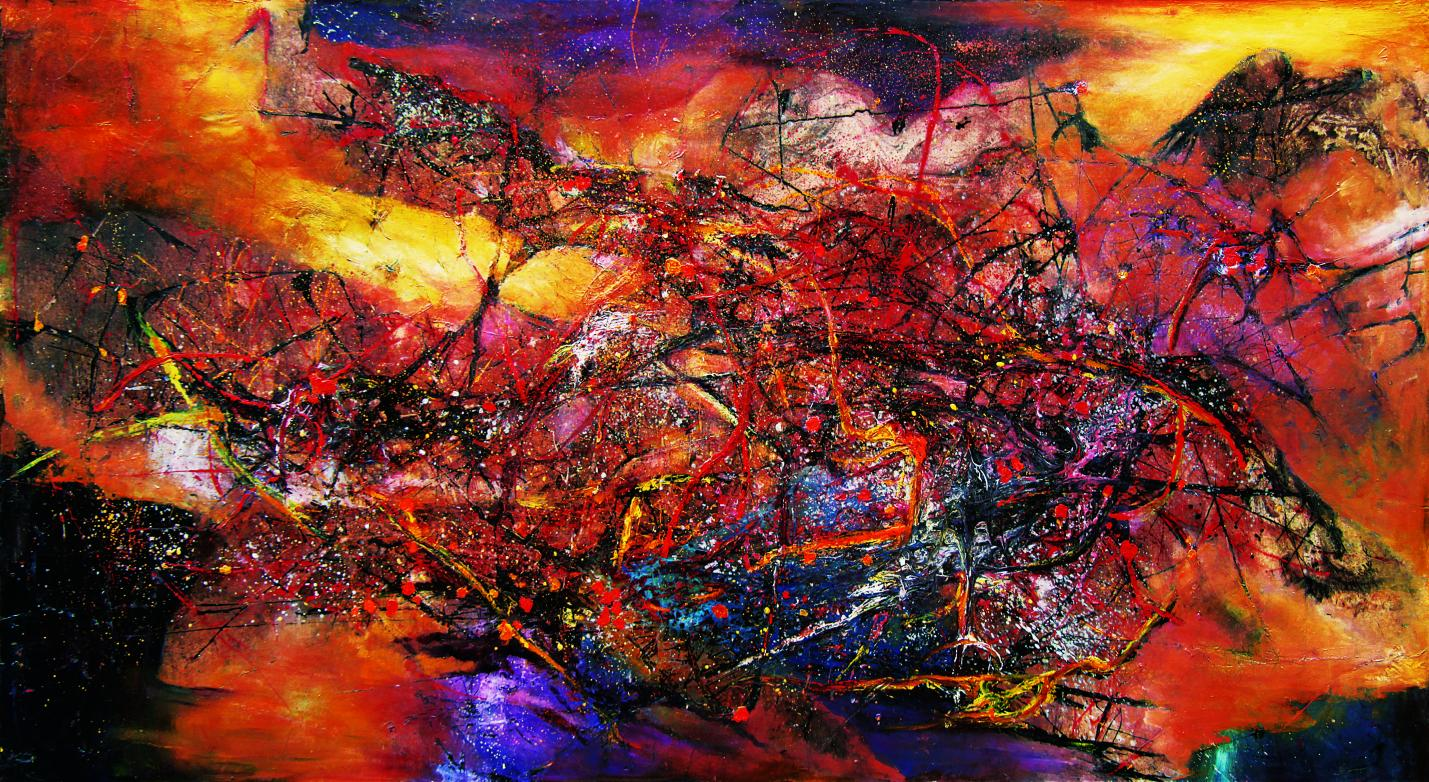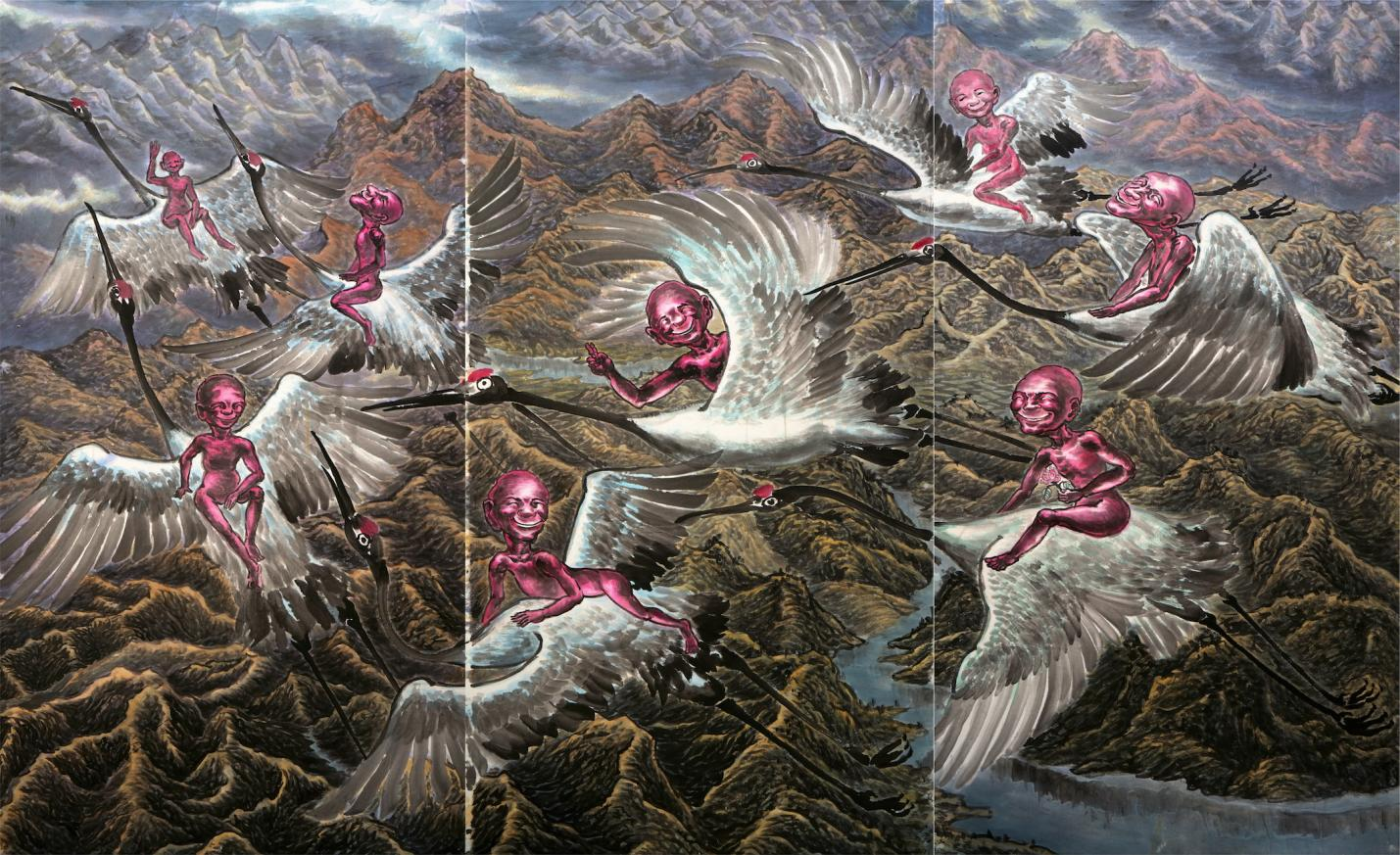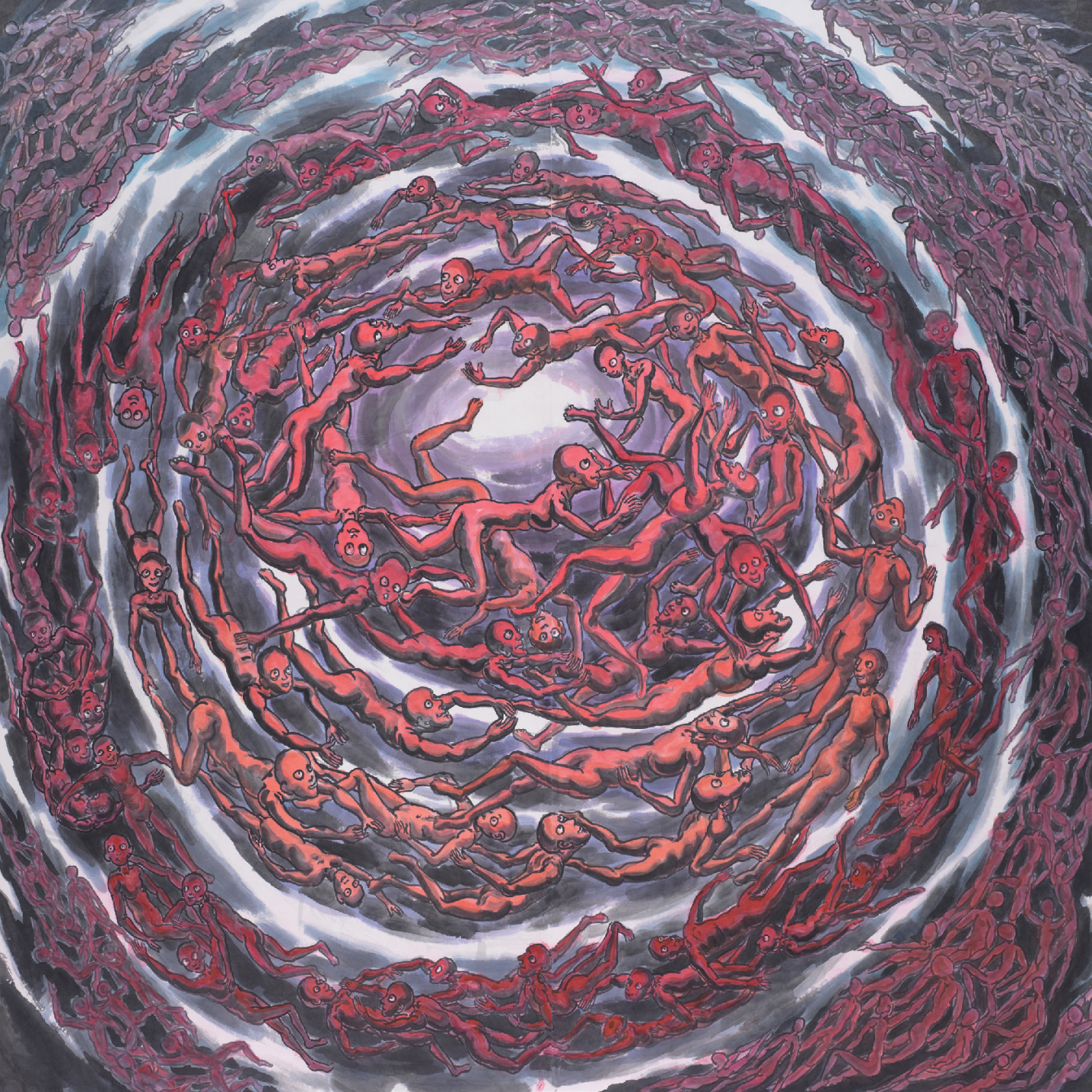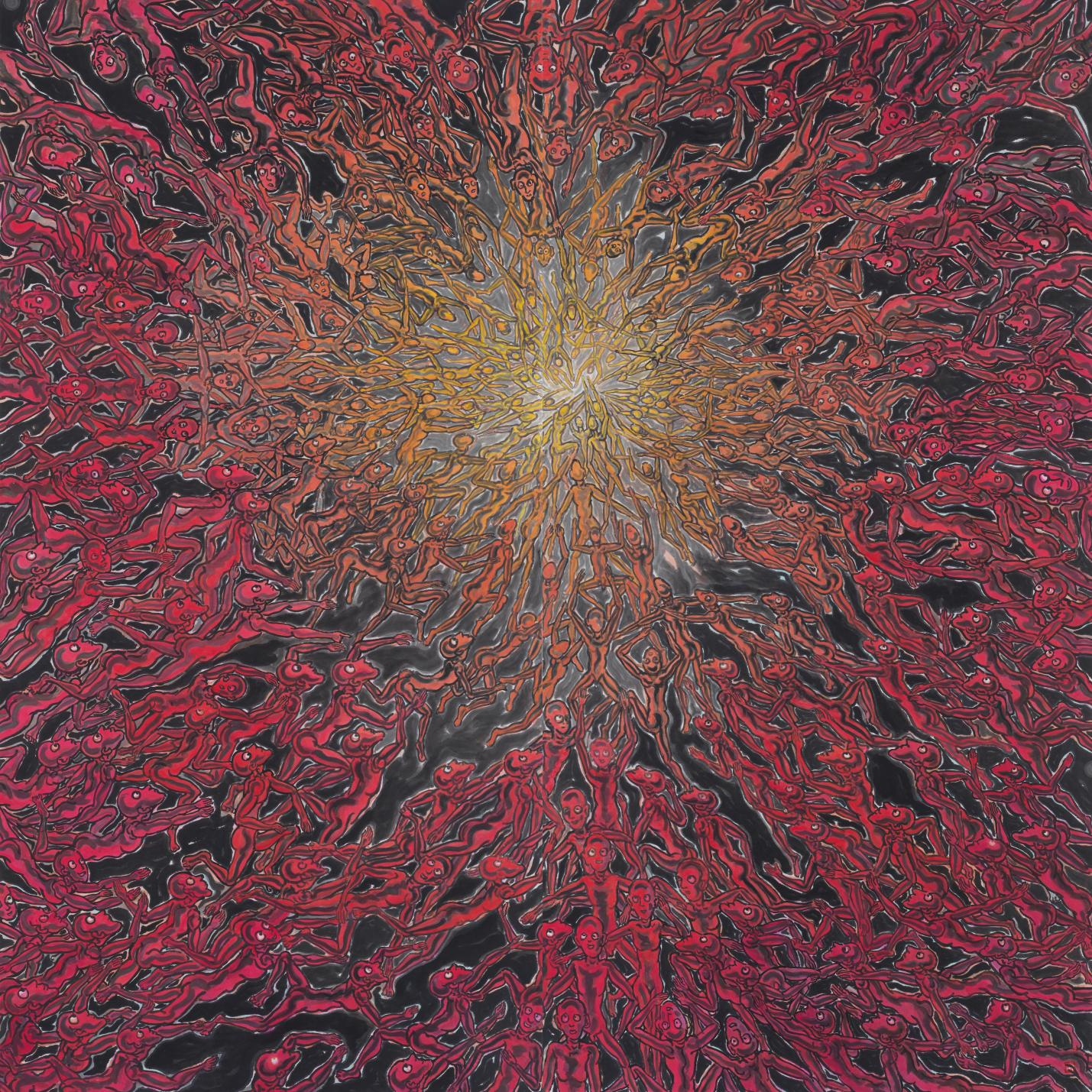Abiding nowhere ——The artistic exploration of Wei Shen
Abiding nowhere
——The artistic exploration of Wei Shen
"Abiding Nowhere" is a quote from the "Diamond Sutra": "Abiding nowhere and awaken the true nature of mind." To abide nowhere can be seen as a portrayal of Wei Shen's wandering artistic journey. From seeking dreams in the Yuanmingyuan Artist Village to studying abroad, in over thirty years of artistic exploration, Wei Shen continuously broke through existing forms. His artistic style evolved from representational to abstract, presenting a diverse appearance.

Artist Wei Shen at Yuanmingyuan Artist Village in Beijing, 1993
Wei Shen was born in Guangxi in 1966, and graduated from the Department of Fine Arts at Guilin Normal College. After graduation, he resigned from his teaching position and pursued his artistic dream in the Yuanmingyuan Artist Village in Beijing, breaking free from institutional constraints. Amidst the bohemian lifestyle of the Yuanmingyuan artistic community, Wei Shen lived with freedom and romantic passion. He boldly experimented with painting forms, creating works imbued with expressionism and surrealism. In the 1980s and 1990s, the Chinese art scene was deeply influenced by existentialist philosophy represented by Sartre, focusing on the individual's existential anxiety. Wei Shen’s works reflected these themes and manifested a resistance to human alienation in modern civilized society.
Wei Shen's childhood in the remote mountains of Guangxi left a deep imprint of the local scenery and folklore, often lingering in his dreams, and were reflected in his early works. Freud's "The Interpretation of Dreams" views dreams as the "fulfillment of wishes" and require deep understanding of the subconscious to interpret. Dreams are a person's dialogue with their inner self, with a paralleled life. Everything seen and felt in the secretive dream world—breath, tears, pain, and joy—is not without meaning. Song Dynasty poet Yan Shu once said, "How long does the dream last? Dispersing like autumn clouds, nowhere to be found." In the hands of the painter, however, dreams take on tangible forms. Wei Shen, with romantic sentiments, ethereal imagery, and free forms, created many dreamscapes. In his works "Heavenly Bird," "Lonely Journey," "Watching Clouds Rise," "Clouds in the City," and "Sign Language," one can feel the poetic essence of dreams and experience the artist's inner confusion and loneliness. The frustrations of life, its deep solitude, often invade Wei Shen's dreams. In such works, colors become dim or melancholic, compositions and images become absurd and abrupt. The emphasis is on the intuitive catharsis of the subconscious, like a wild horse galloping through a boundless field.
In Western modern art history, there are many masterpieces depicting dreamscapes. Surrealist artists were directly influenced by Freud's theories and explore the inner world of the mind. They believed that dreams construct a stage where people could transcend their environment and reconnect with the self-suppressed by society. Salvador Dalí, self-proclaimed as the "painter of painters," is hailed as a master of creating dreams. He inherited superb realistic techniques, creating surreal dreamscapes. Wei Shen's dreamscape, on the other hand, is rather elusive, permeated with eastern mysticism. Wei Shen traveled to many famous mountains and religious sites, paying homage to many eminent monks and studying Buddhism. In works such as "Land Covered with Clocks," "Endless Road," "Wandering," "Palm," and "Wishing Tree," he reveals his devout religious belief and contemplation of life.
"Riding the Crane" is a work imbued with the spirit of Daoism, attempting to bring viewers into the realm of Zhuangzi's carefree wandering. The smiling figure reflects Wei Shen himself in his "Eastern Smile" series. The Smile series is a satirical postmodernist series including "Ashen Hair Protecting Essence," "Golden Road," "Birth of an Artist," "Association," "McDonald's," and "Crowded Smiles." In the work "Ashen Hair Protecting Essence," Wei Shen incorporates Leonardo da Vinci's Mona Lisa, juxtaposing the smile of the classical figure with modern characters, revealing a kind of absurdity. Prior to the Smile series, Wei Shen also created the "Eastern Paradise" series, themed around Chinese cultural elements. In this series, Wei Shen attempted to blend realism and abstraction. Images with Oriental charm, such as cave statues, are presented in concrete forms, while the abstract background accentuates the images’ grandeur.

《The Era of Eruption--from the Oval Series》, 1995, ink on paper, 180×96cm

《Tian Lai Series--Blue Mood》, 1998, oil on canvas,180×96cm
"The Oval Series: Era of Eruption" is an exploration of abstract ink. 58 abstract ink works were exhibited at "Illusion - Wei Shen Art Exhibition" held at the National Art Museum of China in 1998. Unlike Western abstract artists who use oil painting, Wei Shen fully utilized the transparency of ink, allowing water and ink to collide and blend through methods such as splashing, stacking, and rubbing, creating natural effects. After exploring abstract ink, Wei Shen created the "Tianlai Series" of abstract oil paintings, including "Tianlai Series - Blue Mood," "Tianlai Series - Autumn Melody," and "Tianlai Series - Radiant Light." "Tianlai Series - Blue Mood" was completed by Wei Shen after his trip to Tibetan. This abstract work in blue tones reflects Wei Shen's state of mind on the snowy plateau. He used a technique like splashing ink in traditional Chinese painting to create abstract eastern aesthetics.
After the dissolution of the Yuanmingyuan Artist Village, Wei Shen moved to several art districts around Beijing and finally settled in Songzhuang. Amidst tumultuous and wandering years, Wei Shen remained steadfast in his artistic ideals. In 2006, he traveled to the United States for further studies, opening a new chapter in his art. The works exhibited by Wei Shen in the United States attracted the attention of Arthur Kleinman, a Harvard professor and a worldly renowned medical anthropologist. In 2010, Kleinman invited Wei Shen to Harvard University’s "Medical Anthropology China Forum". Wei Shen delivered a speech on "The Development of Contemporary Art in China and the Psychology of Chinese Public", where he proposed the concept of "Art and Mental Health". Professor Kleinman remarked, "The suffering of humanity, the interaction between the individual and the collective, and people's reactions to the evolution of society presented in Wei Shen's works embody the enthusiasm of contemporary Chinese artists for society. Such enthusiasm is precious. This should be an important attitude for contemporary anthropologists, and Wei Shen, as an artist, has boldly and innovatively expressed it through his art."
The concept of art and health has nearly a thousand years of history in the West. Heidegger regarded art as a bridge beyond the everyday world, allowing individuals to transcend the limitations of daily life and contemplate the vastness and depth of existence. The therapeutic role of art is the original intention and purpose of the concept of art and health.

《Tian Lai Series--Melody of Autumn》,1998, oil on canvas, 96×180 cm

《Touring Mountains and Playing Water Series--Ascension on the Crane》, 2018, ink on paper, triptych,each 180×96cm
Painter Matisse once said, "The art I dream of is filled with balance, purity, and tranquility. There are no disturbing or attention-grabbing subjects. Such art is a spiritual comfort, like an armchair for the mind." However, Matisse's avant-garde art was not accepted by the public at the time. The term "Fauvism" reflects the ridicule by conservative academic art. Many modernist avant-garde artists were only accepted by the public later, including Van Gogh, who committed suicide at the age of 37, leaving behind the words "the sadness will last forever." The Paris School painter Modigliani lived a dissolute and impoverished life, only living to 36 years old. Expressionist art has had a profound impact on art from the early 20th century to the present day, but Expressionism and contemporary avant-garde art were denounced by the Nazi government as "decadent art." Kirchner, a core figure of German Expressionism and founder of the "Bridge Society," committed suicide in 1938. From a certain perspective, the therapeutic effect of contemporary art is far less than that of classical art.

《All Living Beings Series--Firmament》, 2020, ink on paper, 240×240cm
The theme of art and health leads to two phenomena to ponder: First, some contemporary artists undergo changes in artistic style due to health reasons. For example, in his later years, Matisse was unable to paint due to physical weakness, but created vivid works with cutouts. Impressionist painter Monet, in his later years due to blurred vision, created abstract works. The second phenomenon is that some disabled artists, such as French painter Lautrec and American photorealistic painter Chuck Close, have transcended their physical pain and created extraordinary works.
Around the theme of art and health, Wei Shen created works for psychological healing, named the "Crowded" series, including "Crowded - Mountain High, Man-made Peak," "Crowded - Compass," "Crowded - Return," "Crowded - Fairy Journey," "Crowded - Wheel of Wind and Fire," "Crowded - Sunshine," "Crowded - Black Hole," etc. These works depicted the public’s tendency toward uniformity and a state of collective numbness. "Crowded - Fairy Journey" has an extremely large canvas, exerting a magnetic attraction that encompasses the viewer. The colors are simple, composed of the primary colors of red, yellow, blue, and black and white. Countless symbolic small figures are arranged neatly. From a local perspective, the picture is concrete, but from an overall perspective, it is abstract. The Crowded series exhibits a repetitive feature, characteristic of "artworks of the mechanical replication era." In the painting process, the artist enters a state of flow. Faced with artworks completed in such a state—ethereal, pure, and free—viewers are also immersed, transcending beyond the constraints of daily life.
Significantly, those of his works were successfully showcased to the public On November 18, 2023, at the "Art and Health" Wei Shen & Yi Ling Contemporary Art Tour Exhibition and Academic Seminar commenced at Beijing Dongyi Art Museum. Featuring 37 paintings by Wei Shen and 23 by Yi Ling, the event delved into the artists' inner worlds, and showcased the unimaginable creative themes, mysterious color transitions, unconscious intuitive touches, and rich visual experiences, guiding people from visual observation to soulful contemplation and subconscious realization, demonstrating the perfect integration of art and mental health. Supported and organized by Peking University Institute of Mental Health and China Rehabilitation Association of Disabled People, promoting the integration of art and mental well-being, it captivated over 300 guests from diverse fields including art, politics, and mental health, garnering their attention and interest, such as Jia Fangzhou, Honorary Chairman of the China Art Critics Annual Conference and member of the Curatorial Committee of the Tsinghua University Art Museum, and Su Dan, Deputy Director of the China National Arts and Crafts Museum and the China Intangible Cultural Heritage Museum. They lauded Wei Shen's "subconscious" artworks, heralding the journey of inner awakening and wisdom. Yi Ling's "graffiti-style" abstract paintings uniquely influence color perception. Together, their works serve as vital conduits for spiritual healing in contemporary society.

《Crowded Series--Compass》, 2019, ink on paper, 180×180cm

《Crowded Series--Sunshine》, 2020, ink on paper, 240×240cm

《Crowded Series--Immortal Travel》, 2021, ink on paper, triptych, each 390×120 cm
- Chinese college students use "grass" to purify the air!
- Explore the mountains and seas, marvel at scientific and technological innovation! The side of Shenzhen that makes foreign tourists linger and forget to leave
- Abiding nowhere ——The artistic exploration of Wei Shen
- HogoGroup will acquire full ownership of UK company GRAEFF
- L7 Participates in the Hong Kong Institutional Investment Forum by Bloomberg
- The Peak of WEB3, Forging a New Business Model - The Dandelion Platform
- Dogecoin Ecology: Explore a unique ecosystem!
- WH&R Achieves Record Growth in AP in 2023
- Profil Perusahaan SLKOR
- Coolslimming appeared on the big screen of NASDAQ
- 붉은 악마 기사: AI와 Web3를 융합하여 축구 금융을 혁신하다
- 欧洲品质 乐享世界!全新一代HOWO轻卡统帅PRO震撼登场
- Red Devil Knight: Revolutionizing Football Finance with AI and Web3
- TaoLi Future Group's Visit to Southeast Asia, Promoting High-Quality Development of International Chinese Education
- The Peak of WEB3, Forging a New Business Model - The Dandelion Platform
- State Grid Corporation of China Creates "Green Ark" in Zhejiang to Protect Biodiversity
- State Grid Corporation of China Creates "Green Ark" in Zhejiang to Protect Biodiversity
- With a valuation of 300 million dollars, the U.S. technology company ARCELL dive into the AR market
- What is the reason for the frequent deaths of Falun Gong practitioners
- Promoting Quality and Efficiency in Chengmai's Economic Development to Accelerate Sector Growth